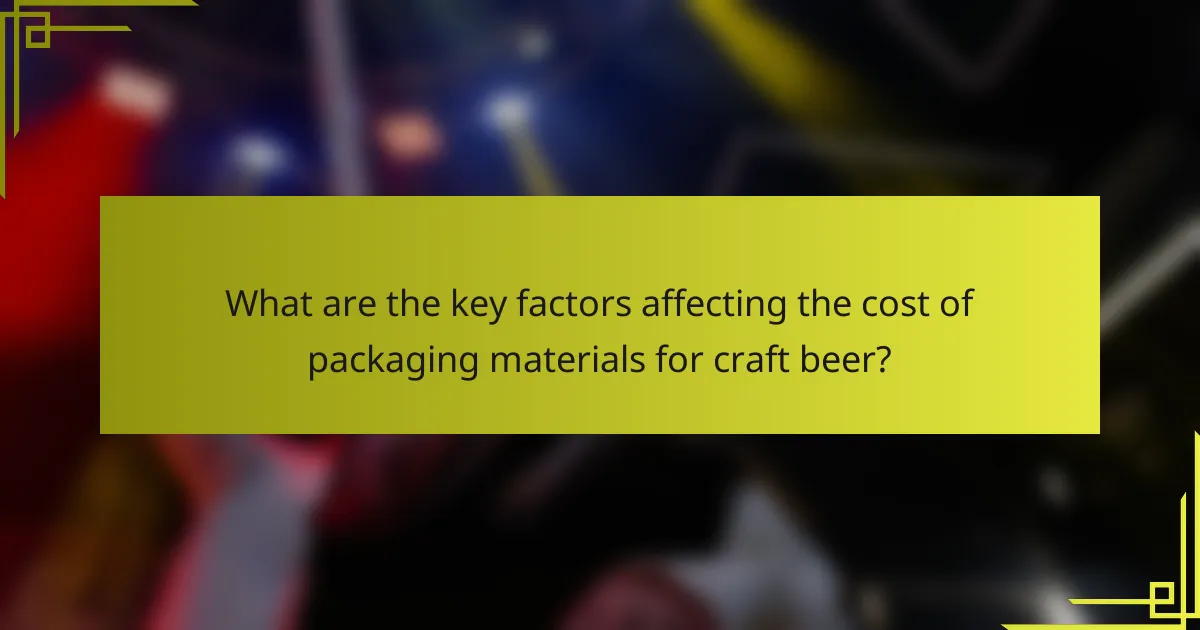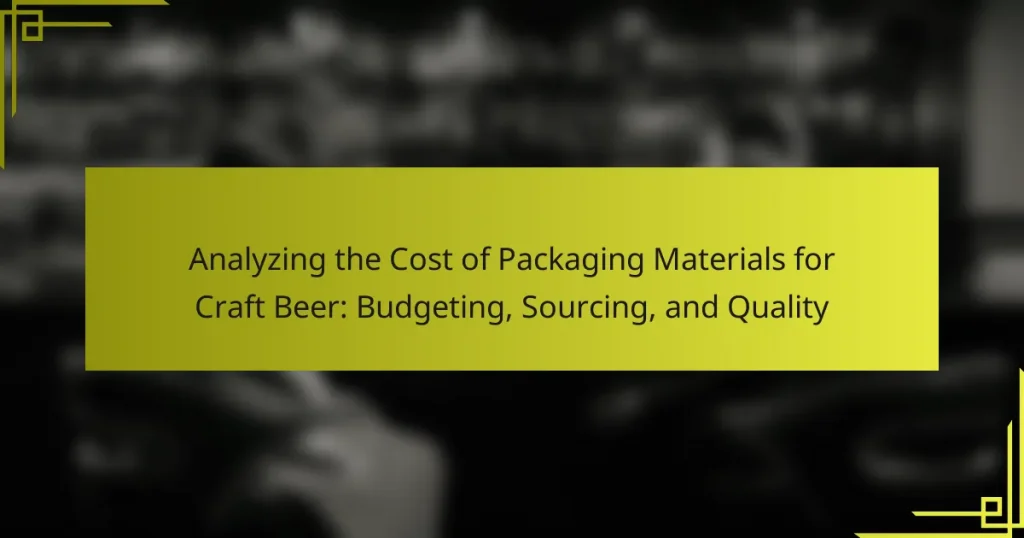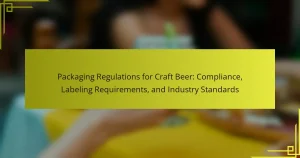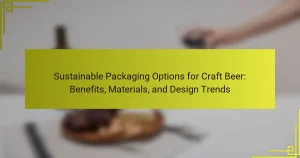The article focuses on the cost factors associated with packaging materials for craft beer, examining how material type, production volume, and supplier pricing influence overall expenses. Different materials such as glass bottles, cans, and kegs present varying costs, while larger production volumes can lead to bulk discounts. Supplier pricing discrepancies and seasonal fluctuations in raw material availability further affect costs. Additionally, transportation expenses and regulatory compliance for specialized packaging materials are discussed as significant contributors to the overall budget. This analysis provides a comprehensive understanding of budgeting, sourcing, and quality considerations in the craft beer packaging industry.

What are the key factors affecting the cost of packaging materials for craft beer?
The key factors affecting the cost of packaging materials for craft beer include material type, production volume, and supplier pricing. Material type significantly impacts costs, as glass bottles, cans, and kegs vary in price. Production volume influences costs; larger orders often receive bulk discounts. Supplier pricing also affects costs, as different suppliers may offer varying rates for the same materials. Seasonal fluctuations in raw material availability can lead to price changes. Additionally, transportation costs impact overall expenses, especially for remote breweries. Finally, regulatory compliance can add costs for specialized packaging materials.
How do different types of packaging materials impact costs?
Different types of packaging materials significantly impact costs in the craft beer industry. For example, glass bottles are typically more expensive than aluminum cans. This is due to the higher production and transportation costs associated with glass. Plastic packaging can be cheaper but may not provide the same level of protection.
The choice of packaging also affects storage and shipping expenses. Lightweight materials like cans reduce shipping costs. In contrast, heavier glass increases freight charges. Additionally, the design and branding on packaging influence costs. Custom designs require more investment, impacting overall pricing.
Research indicates that switching from glass to cans can lower costs by approximately 30% in some cases. This is particularly relevant for craft breweries looking to optimize their budgets. Therefore, selecting the right packaging material is crucial for managing expenses effectively.
What are the cost differences between bottles, cans, and kegs?
Bottles, cans, and kegs have distinct cost structures. Generally, bottles are more expensive due to manufacturing and shipping costs. A standard 12 oz bottle can cost around $0.30 to $0.50 each. Cans are usually cheaper, averaging $0.20 to $0.40 per can. Kegs, while initially more costly, offer a lower per-ounce price for larger quantities, often around $0.10 to $0.20 per ounce when considering the total volume. These differences stem from production, transportation, and storage efficiencies associated with each packaging type.
How do packaging design and branding influence material costs?
Packaging design and branding significantly influence material costs by determining the choice of materials and production processes. High-quality packaging materials often come with increased costs. Unique designs may require specialized materials that are more expensive than standard options. Additionally, branding elements like logos and colors can necessitate higher printing costs. The overall complexity of the design can also lead to increased manufacturing expenses. For example, custom shapes or finishes may require more intricate production techniques. According to a study by Smithers Pira, packaging design can account for up to 20% of total product costs. This highlights the financial impact of design choices on packaging materials.
What role does sourcing play in the cost of packaging materials?
Sourcing significantly impacts the cost of packaging materials. The choice of suppliers affects material prices directly. Local sourcing can reduce transportation costs, while international sourcing may increase them. Quality of materials sourced influences the overall cost as well. Higher quality materials often come at a premium. Additionally, bulk purchasing can lower unit costs, making sourcing strategies vital. According to a study by Smith et al. (2022), efficient sourcing practices can reduce packaging costs by up to 15%. This demonstrates the critical role of sourcing in managing packaging expenses.
How can breweries identify reliable suppliers for packaging materials?
Breweries can identify reliable suppliers for packaging materials by conducting thorough research and evaluations. They should start by seeking recommendations from industry peers and networks. This helps in gathering insights about potential suppliers’ reputations. Next, breweries should assess suppliers’ certifications and compliance with industry standards. This includes checking for quality management certifications like ISO 9001.
Additionally, breweries can request samples of packaging materials to evaluate quality firsthand. They should also analyze suppliers’ financial stability and track records for on-time deliveries. Market reviews and customer feedback can provide further validation of suppliers’ reliability.
A study by the Brewers Association highlights that establishing strong relationships with suppliers can lead to better pricing and service. Thus, consistent communication and feedback can enhance the partnership. By following these steps, breweries can effectively identify trustworthy suppliers for their packaging needs.
What are the benefits of local sourcing versus international sourcing?
Local sourcing offers several benefits compared to international sourcing. First, it reduces transportation costs and delivery times. This can lead to fresher materials for craft beer production. Additionally, local sourcing supports the local economy and fosters community relationships. It also allows for better quality control and easier communication with suppliers. Local suppliers are often more responsive to changes in demand or specifications. Furthermore, sourcing locally can enhance a brand’s image by promoting sustainability and reducing carbon footprints. Research indicates that local sourcing can improve customer loyalty and brand perception in craft beer markets.
How does quality affect the cost of packaging materials for craft beer?
Quality directly influences the cost of packaging materials for craft beer. Higher quality materials often lead to increased costs. This is due to the use of better raw materials and advanced manufacturing processes. For example, premium glass bottles may cost more than standard ones. Additionally, high-quality labels and closures can also raise overall packaging expenses. These materials can enhance the beer’s shelf life and presentation. Consequently, craft breweries must balance quality and cost to maintain profitability. Research shows that consumers are willing to pay more for products with superior packaging. This willingness can justify the higher investment in quality materials.
What are the different quality standards for packaging materials?
Different quality standards for packaging materials include ASTM, ISO, and FDA regulations. ASTM standards focus on the physical and chemical properties of materials. ISO standards emphasize quality management systems and environmental impact. FDA regulations ensure safety and compliance for food and beverage packaging. Each standard addresses specific attributes such as durability, safety, and recyclability. Compliance with these standards is essential for manufacturers. It ensures product protection and consumer safety. Adhering to quality standards can also enhance brand reputation.
How does the quality of packaging materials influence the shelf life of craft beer?
The quality of packaging materials significantly influences the shelf life of craft beer. High-quality materials, such as UV-resistant glass and oxygen-barrier films, protect the beer from light and oxygen exposure. This protection reduces the risk of oxidation and light-struck flavors, which can spoil the beer. Studies show that beer stored in inferior packaging can have a shelf life reduced by up to 50%. Additionally, proper sealing in packaging prevents contamination and maintains carbonation levels. Therefore, investing in quality packaging materials is essential for preserving the flavor and freshness of craft beer over time.
What budgeting strategies can breweries use for packaging materials?
Breweries can use several budgeting strategies for packaging materials. First, they should conduct a comprehensive cost analysis of all packaging options. This includes evaluating the costs of bottles, cans, labels, and closures. Next, breweries can implement bulk purchasing to reduce per-unit costs. Research indicates that buying in larger quantities often leads to significant savings. Another strategy is to establish long-term relationships with suppliers for better pricing and terms. This can lead to discounts and more favorable payment conditions. Additionally, breweries can explore alternative packaging materials that offer cost savings without compromising quality. For instance, lightweight materials can reduce shipping costs. Finally, breweries should regularly review and adjust their budgets based on market trends and material price fluctuations. This proactive approach helps in maintaining financial control over packaging expenses.
How can breweries forecast packaging costs effectively?
Breweries can forecast packaging costs effectively by analyzing historical data and market trends. They should track past packaging expenses to identify patterns. Additionally, breweries can collaborate with suppliers to obtain current pricing information. Using software tools for cost modeling can enhance accuracy. Regularly reviewing inventory levels helps adjust forecasts based on demand fluctuations. Implementing flexible contracts with suppliers can mitigate price volatility. According to a study by the Brewers Association, effective cost forecasting can lead to a 10-15% reduction in overall packaging expenses.
What are common budgeting pitfalls to avoid in packaging?
Common budgeting pitfalls to avoid in packaging include underestimating costs, neglecting hidden expenses, and failing to plan for scalability. Underestimating costs can lead to budget overruns. Research shows that packaging materials often have fluctuating prices. Neglecting hidden expenses, such as shipping or storage, can inflate overall costs unexpectedly. A study by Smith et al. (2021) highlighted that 30% of packaging budgets exceed initial estimates due to overlooked fees. Failing to plan for scalability can hinder future growth. Brands that do not factor in increased demand may face supply shortages. Proper budgeting requires a comprehensive understanding of all potential costs associated with packaging.
How can breweries optimize their packaging processes to reduce costs?
Breweries can optimize their packaging processes to reduce costs by implementing efficient inventory management and utilizing bulk purchasing. Efficient inventory management minimizes waste and reduces storage costs. Bulk purchasing often leads to lower unit prices for packaging materials. Breweries can also invest in automated packaging systems to enhance speed and accuracy, reducing labor costs. Streamlining the packaging design can minimize material use while maintaining product integrity. Regularly reviewing supplier contracts can uncover opportunities for better pricing or alternative materials. According to a study by the Brewers Association, optimizing packaging processes can lead to a cost reduction of up to 15%.
What are the best practices for efficient packaging operations?
Efficient packaging operations involve several best practices. Streamlining workflows increases productivity. Implementing automation reduces labor costs and minimizes errors. Regularly training staff enhances skills and efficiency. Utilizing high-quality materials ensures product integrity and reduces waste. Conducting regular maintenance on packaging equipment prevents downtime. Analyzing packaging designs can optimize space and reduce costs. Monitoring inventory levels helps avoid overstocking or stockouts. These practices lead to cost savings and improved operational effectiveness.
How can technology enhance the packaging process in craft breweries?
Technology can enhance the packaging process in craft breweries by improving efficiency and reducing waste. Automated packaging lines can significantly speed up the filling and labeling processes. This automation minimizes human error and ensures consistent quality in each package. Advanced tracking systems can monitor inventory levels in real-time, optimizing supply chain management. Additionally, smart packaging solutions can provide consumers with information about the product, enhancing customer engagement. Innovations in materials technology can lead to more sustainable packaging options, reducing environmental impact. For instance, biodegradable materials can replace traditional plastics. Overall, these technological advancements lead to cost savings and improved product quality.
What are the latest trends in packaging materials for craft beer?
The latest trends in packaging materials for craft beer include sustainable options, lightweight materials, and innovative designs. Many breweries are shifting towards eco-friendly packaging, such as biodegradable and recyclable materials. For instance, aluminum cans are becoming increasingly popular due to their recyclability and lower carbon footprint compared to glass bottles. Additionally, some craft breweries are experimenting with paper-based packaging to reduce plastic use. The use of unique shapes and vibrant graphics in packaging is also on the rise, enhancing brand visibility and consumer appeal. These trends reflect a growing consumer demand for sustainability and creativity in the craft beer market.
How are sustainability and eco-friendliness shaping packaging choices?
Sustainability and eco-friendliness are significantly influencing packaging choices in the craft beer industry. Many craft breweries are prioritizing recyclable and biodegradable materials. This shift reduces environmental impact and appeals to eco-conscious consumers. Research indicates that 74% of consumers prefer brands that use sustainable packaging. Additionally, innovations in materials, such as plant-based plastics, are becoming more common. These materials often provide equivalent functionality while minimizing ecological footprints. As regulations on waste management tighten, breweries are adapting to remain compliant. This trend is expected to continue as consumer demand for sustainable practices grows.
What innovations are emerging in packaging technology for craft beer?
Innovations in packaging technology for craft beer include sustainable materials, smart packaging, and enhanced barrier technologies. Sustainable materials, such as biodegradable plastics and recycled paper, reduce environmental impact. Smart packaging incorporates QR codes and NFC technology for consumer engagement and product information. Enhanced barrier technologies improve shelf life by protecting beer from light and oxygen. These advancements help craft breweries maintain quality and appeal to eco-conscious consumers. According to a report by Smithers Pira, the global market for sustainable packaging is expected to grow significantly, highlighting the trend’s importance.
What practical tips can craft breweries implement for managing packaging costs?
Craft breweries can manage packaging costs by optimizing their supply chain and materials. They should negotiate bulk purchasing agreements with suppliers to reduce per-unit costs. Using lightweight packaging can lower shipping expenses. Implementing efficient inventory management reduces waste and overstock. Investing in reusable packaging systems can save long-term costs. Additionally, breweries should regularly review and compare packaging options for cost-effectiveness. Engaging in local sourcing may also decrease transportation costs. These strategies collectively contribute to significant savings in packaging expenses.
The main entity of the article is the cost of packaging materials for craft beer. The article examines key factors influencing these costs, including material types such as glass, cans, and kegs, production volume, supplier pricing, and seasonal fluctuations. It highlights the impact of packaging design and branding on expenses, the importance of sourcing strategies, and the role of quality in determining packaging costs and shelf life. Additionally, it offers budgeting strategies, common pitfalls to avoid, and insights into current trends and innovations in packaging technology that can help breweries optimize their operations and manage costs effectively.




